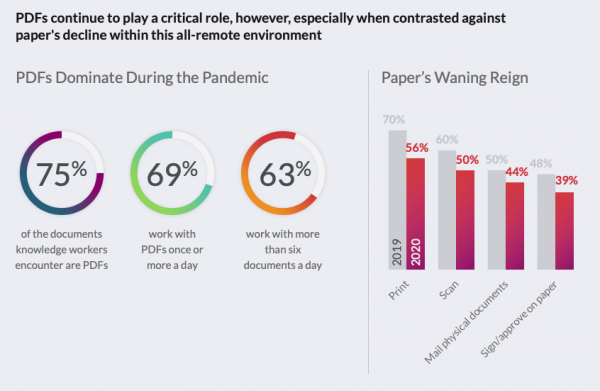The Age of the Paperless Office

We know that Coronavirus can live on surfaces for up to 72 hours. Ideally, we would have a totally electronic document office by now – banishing paper to history. Of course, the paperless office has failed to become a reality. Silicon UK considers how businesses could adopt more electronic document management techniques to reduce the risk of COVID infection.
The promise of the paperless office has been evolving for decades, yet the reality for all enterprises is they still use massive quantities of paper. Indeed, according to Forrester, every 24-hours one billion photocopies are made, with Gartner estimating that the amount of paper in an average-sized company is growing by 25% a year. At least that was the case pre-COVID.
In June, analysts IDC, predicted: “Page volume will fall 13.7% in 2020, from 3.2 trillion pages in 2019 to 2.8 trillion pages in 2020.” Paper, it seems, is not going to be fit for purpose in a post-COVID-19 working environment.
As businesses have had to radically alter how they operate, document management has clearly moved wholesale towards digital assets. Technologies such as OCR (Optical Character Recognition) now offer high levels of accuracy.
Digitally signing documents also continues to expand and become the norm across many business sectors. And as workforces move to their homes, accessing documents in their digital form, securely, is paramount. So, is the paperless office going to finally materialise?
Speaking to Silicon UK, Gina O’Reilly, COO at Nitro Software explained: “Our hope is that businesses can work 100% digitally at some point, but we know that change won’t happen overnight. The biggest challenges we see when organisations make a move to digital solutions are IT buy-in, training, and cost. In fact, our most recent report shows the top barriers as IT being too busy (42%), limited budgets (41%) and lack of training and support (38%).

[SOURCE: nitro.]
Gina continued: “Most businesses can go paperless using document productivity and eSigning tools. We work with companies in many different industries including financial services, professional services, legal, manufacturing, energy/oil, and real estate.”

Businesses are clearly overhauling every aspect of their processes, many of which had relied upon using masses of paper documents. Some enterprises have, though, been innovating. Wayne Oakes, Director of multi-disciplinary engineering consultancy Dice Consulting outlined their approach: “Since launching the business in 2018, we have set out to be a paperless organisation with a view to not only reducing paper waste but predominantly to help streamline critical processes and improve efficiencies for our clients.
“Working remotely will undoubtedly restrict organisations from printing and bulky paperwork, but we recommend that they embrace the change. We are convinced that being paper-free allows our business to move faster than the competition by improving our workflow, whether working remotely or not.
“Using digital forms and electronic signatures saves time that would normally be spent printing documents and storing hard copies. Digital processes also allow us to automate routine tasks and collaborate with the team much easier. By embracing a digital workplace, our team naturally has more time to spend on customer service and client satisfaction.”
All businesses have continued on their digital transformation journeys. The pandemic has accelerated these plans. Clearly, how paper is used across their enterprises is now being carefully assessed.
Jonathan Richards, CEO and Founder of Breathe, explained to Silicon UK: “The pandemic has made many businesses re-evaluate and streamline processes to accommodate staff working remotely. The exodus from the traditional office setting has made digital the only option — documents which would once be used during a meeting are now shared via email and spreadsheets are stored in central systems. These formats existed before, but now they are a necessity.
“Digitalisation extends to process management too. As remote work looks set to continue for many, it’s no longer feasible to rely on sensitive paper documents filed away in an office which is no longer used. Holiday entitlement, sick leave information and rota schedules, for example, need to be immediately available and organised in a concise way which is easy for HR managers to understand and update. The pandemic has intensified the need for businesses to get on top of their people admin especially — tracking who is on furlough or out sick and their entitlements is critical for remaining compliant of government guidelines.”
Digitising assets
Digital Asset Management (DAM) has existed for decades. Paper, though, has stubbornly refused to relent to the digital age. Of course, the PDF has become ubiquitous, but DAM on a large scale looks set to transform many aspects of every business.
“Conga research found that for 89% of businesses, the key to successful digital transformation is getting a grip on the way that documents and contracts are created, managed, and stored across the organisation,” said Ash Finnegan, Digital Transformation Officer at Conga, the digital document transformation specialists.
“Organisations have quickly realised the importance of properly structuring data and insights, that is, effectively managing and streamlining the processes around their everyday documents – it is an assured way of improving the performance of their business. Our research also found that 86% of companies have already standardised and automated manual processes throughout their organisations or are in the process of doing so, and this will likely be accelerated further throughout the ongoing pandemic.”
A critical consideration when any business moves to digital documentation – some of which could be highly sensitive – is how security will be handled. Silicon UK asked Lee Hazell, Principle Consultant, Risk Advisory, SureCloud for his views: “While ‘digitising’ business data can offer numerous security benefits in terms of centralised access control, audit trails, encryption, backup and restore capabilities, there are additional security challenges businesses need to be aware of,” Lee explained.
“For paper-based assets, securing physical storage locations is the primary consideration, this contrasts with digital assets where data can be accessed, modified, shared, stored, retained, and destroyed in numerous ways. As digital assets can be downloaded and stored locally on mobile devices, shared via email or cloud hosting services and transported via removable media and other mechanisms, securing data when ‘out in the wild’ are challenges every organisation needs to carefully consider.”
Also, Guy Phillips, Vice President of International Business at NetDocuments pointed out: “Shifting to a digitalised way of working is not a simple process that will happen overnight. For many businesses, there is often a reluctance to let go from paperless processes as they fear added complexities. This means that companies are continuing to spend thousands each year on-premises just to store documents or getting someone to archive the documents on their behalf.

“Equally shadow IT remains a threat if existing systems prevent employees from being easily able to store and share documents, forcing them to use personal email and devices. In a bid to go paperless, organisations must ensure they equip employees with the right tools. Employees need document and email management tools that enhance rather than hinder the way they work. It requires more than just an aesthetically pleasing interface. To ensure adoption, tools must truly integrate into the day-to-day life of employees and work natively from within applications they are familiar using.”
COVID paperless office
Creating a paperless office can’t be accomplished overnight. “A key challenge for businesses when it comes to going paperless is ensuring that everyone in an organisation is au-fait with the new digital processes,” Breathe’s Jonathan Richards continued. “For some, removing paper is a daunting prospect, so ensuring that everyone is comfortable with and understands how to integrate software alongside their daily tasks remains a challenge but is a priority. The pandemic has exposed IT knowledge gaps that can seriously slow down operations, which no business can afford right now.
“Another issue is uploading and transferring documentation from the filing cupboard to an online platform. Manually inputting swathes of data into these systems is highly time-intensive. This is why incremental updates of different business operations are key. HR, CRM, marketing all function more efficiently without paper getting in the way, but getting there is the challenge.”
Also, Olivier Pin, VP Product Management, DocuSign explained: “Changing long-standing processes and procedures is rarely straightforward; ingrained practices can be difficult to supplant. However, when the benefits of change are fully understood, the transition becomes a lot easier to manage as resistance is minimised.

“For example, in a paper-based environment data is locked away in physical filing cabinets and desk draws. It’s difficult to access and analyse and hard to share. If you transfer that data into a digital environment, it can be studied and evaluated in a far more collaborative way; and quicker, too. It can be interrogated to produce useful insights that would otherwise have been impossible.
“Extracting real value from archived data becomes a feasible reality when businesses move away from paper-based processes. These sorts of tangible benefits will help convince even the most paper-loving person to switch to digital alternatives and hopefully convert them into evangelists for a paperless culture.
Olivier concluded: “Even for companies that had started to remove paper processes, such as through the use of eSignatures, it became clear that they were still being hampered by manual tasks while preparing contracts, or when the time came to execute or manage them. This was often made worse by the fact that their digital systems, such as CRM and ERP, have remained largely disconnected.
Eradicating paper from business, is perhaps, a bold and almost unobtainable goal. However, what is likely to occur is the emergence of the ‘paper lite’ office when in centralised spaces or the home.
Says Steve Holmes, EMEA Regional Director, PaperCut: “The stumbling block to the paperless office has always been that it’s an unrealistic goal for many organisations. It has been said that a ‘less paper’ office is a more realistic ambition, and it’s one that intelligent print management solutions have helped many organisations to achieve.
“If the pandemic has had an impact on reducing print volumes, it’s by virtue of staff not being in the office for the best part of six months. However, with staff working remotely, where print takes place has now shifted from the office to the home. That’s a scenario that organisations really need to think about and not overlook because there are sound reasons for closely monitoring printing from home and encouraging different print behaviour. The first driver is – unsurprisingly – cost. At a time when some businesses have experienced a decline in growth during the last quarter, the cost of home printing is sobering; within the industry, it is estimated that printing to a desktop device can cost up to five times more compared to an office-based A3 multifunction device, increasing the risk of print costs escalating exponentially.
“The second driver is security. Back in the office-work days, print management solutions could be effectively combined with robust policies to reduce document-based data leaks; not necessarily so at home. And the expectations of GDPR haven’t gone away; now more than ever, companies need to keep a watchful eye on what is being printed and whether those prints are secure.
“When staff return to the workplace, what will be interesting to observe is whether companies – which have had to endure six months of little or no growth – will apply even more stringent measures to control their print costs. If so, that takes us back to where we started; the ‘less paper’ office, rather than the paperless one.”
A future without paper?
Can business move to a completely paperless working environment? This may be optimistic, but the new company normal will certain remove massive quantities of paper from business processes.
Says Lynda Kershaw, Marketing Manager at Macro 4: “One of the main challenges is adapting legacy systems that produce paper. Companies are understandably reluctant to start making major systems changes when they may already be understaffed due to the pandemic. However, a good digital document management platform should be able to digitize and adapt the output that these older systems already produce, so you don’t need to touch your existing technology stack. You could take a document like a traditional order, report or invoice, for example, and turn it into something more appealing for a mobile phone user: a simpler format, perhaps, but more interactive.”

Conga’s Ash Finnegan concluded: “Throughout the past few months, COVID-19 has proven an excellent challenge for the government and businesses alike. Just over the last year, we have seen several regulatory changes – which have likely been accelerated as a result of the ongoing pandemic and challenges associated with social-distancing measures. For example, we have witnessed FCA recognise and validate electronic signatures for fund management companies given the inability to wet sign (i.e. physically sign) in-person during the peak of lockdown. Similarly, HM Land Registry has recognised the use of ‘witnessed electronic signatures’ for vital property dealings – from mortgages and leases to transfers of ownership – making it faster and more accessible for people to move home safely.
“Whilst these are indeed uncertain times, it has brought forth great change and innovation. Regulations are being constantly updated to ensure continuity for businesses and the public and these are welcome changes both operationally and as the market becomes increasingly volatile. Digital technologies offer more practical solutions given market volatility and are gradually being accepted by authoritative and government bodies.”
SureCloud’s Lee Hazell also commented: “Digital document management platforms can provide a wealth of benefits when compared with maintaining paper-based records. From an indexing and searchability perspective, management platforms enable organisations to store, organise, search, and collaborate seamlessly efficiently.
“From a security perspective, access management, encryption of data at rest, audit logging, and secure retention and destruction are just some of the benefits that can be realised when compared with paper-based records. Organisations should consider the types and volumes of data processed, as well as the security features and configuration options of the document management platform on their journey to operating a paperless business.”
It is more realistic for enterprises to move to a ‘paper lite’ business, as paper, it seems, remains a core component of all company processes. A paperless office may eventually appear, but for now, the radical changes businesses will move through post-COVID-19, will mean less paper is used to create the COVID paperless office.